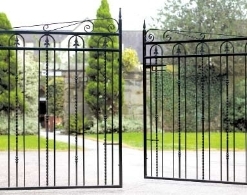Planning Permission & Building Regulations
Is Planning Permission & Building Regulations Approval Required?
If you are considering purchasing one of our high-quality metal gates, fences panels or railings and are concerned about the need for planning permission, we recommend you read the information detailed below, or for the most accurate information within your area, refer directly to your local planning office.
Planning Permission
According to the government's online Planning Portal website, you will need to apply for planning permission in the following instances.
- If the gate, fence or railings are over the height of 1000mm and they are to be installed next to a public highway or footpath. For other areas of your property, you will need to gain permission if the height is over 2000mm.
- If a planning condition (such as an Article 4) is in place which removes your right to erect or adjust a fence, gate or wall.
- Your property is a listed building or falls within the curtilage of a listed building or where the gate or fence creates a boundary with an adjacent listed building.
With the exception of properties located within a conservation area (which may require permission for demolition and removal), planning permission is not required if you are taking down an existing fence or gate or plan to maintain and improve a gate or fence (regardless of height) provided its height once reinstated is not higher than the original.
Building Regulations
Although the installation of a gate, fence or railing does not require building regulations approval, it is essential the structure is of sufficient strength for its intended purpose and be in a structurally sound condition.
Party Walls
Where the property has a garden wall dividing your land from an adjoining property, the wall is classed as a “Party Wall” and is covered under the Party Walls Act 1996. It may therefore be necessary to notify your neighbours of the work you will be completing. For clarification, whether this applies to you, read more about this act here.
Inspection
Due to the fact that garden and boundary walls are the most likely to collapse and cause damage to members of the public, it is recommended they are inspected periodically to assess the overall condition.
Aside from the general deterioration of the structure, which comes about through exposure to the elements, there are several other factors by which a wall may become affected, including;
- Increased wind loads and exposure to driving rain (as a result of adjacent walls being removed)
- The cutting down of mature trees near the wall or the planting of new trees.
- Alterations to the property leave it at a greater risk of damage from passing traffic.
- Creating openings within existing walls (for a new access gate) or removal of pillars.
Things to consider before adding a gate to an existing wall
- What is the overall condition of the brickwork? Pay special attention to crumbling bricks, as walls will become weak if the problem is prevalent throughout the structure.
- Is the pointing in good condition? Pointed brickwork will form a durable barrier against water penetration. Where mortar is missing, cracked or soft, the joints will need raking out and re-pointing with an appropriate sand/cement mix.
- Is the wall in the vicinity of a tree? Damage to foundations is a problem where trees are close to a wall. Over time the roots will grow under or push the concrete foundations resulting in cracks appearing across the full height of the wall. As a result of this, damaged areas will need rebuilding in an appropriate manner to prevent the same thing happening again.
- Is the wall vertical? There can be many reasons why a wall is not vertical, including tree roots, insufficient foundations or even a collapsed drain. As such, if the wall leans to such an extent that it poses a safety risk, it should be demolished and rebuilt.
- Is the wall of sufficient thickness? Where the wall will be taking the weight of a heavy pair of gates, it is essential that the structure is capable of providing a safe means of support. If you are unsure, we recommend you seek professional advice.
- Is there any known traffic damage? Brick pillars at the entrance of the driveway are prone to be hit by vehicles entering and exiting the space. As such, if the pillar has any known damage or shows obvious signs of a problem, it should be demolished and rebuilt in the correct manner (we recommend steel re-bar is bent into the pad foundation and the brick pillar is then built around it. Once complete the hollow core should be filled with concrete to provide a solid mass).
Disclaimer
The above information is intended to provide general guidance and should not be relied upon as a source for legal information. Professional advice should always be sought when completing any building work, structural alterations or making an addition to your property that could affect the safety or may lead to planning issues at a later date. Metal Gates Direct, therefore, accepts no liability if this information is solely relied upon.



